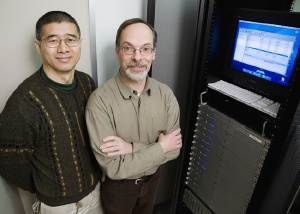Aug 18 2008
A new study of transfer RNA, a molecule that delivers amino acids to the protein-building machinery of the cell, challenges long-held ideas about the evolutionary history of protein synthesis.
 Illinois crop sciences professor Gustavo Caetano-Anollés and postdoctoral researcher Feng-Jie Sun discovered that the two functional regions of the transfer RNA molecule have different evolutionary histories.
Illinois crop sciences professor Gustavo Caetano-Anollés and postdoctoral researcher Feng-Jie Sun discovered that the two functional regions of the transfer RNA molecule have different evolutionary histories.
In the study, researchers report that the dual functions of transfer RNA (reading the genetic blueprint for a protein, and adding a specific amino acid to the protein as it is formed) appear to have originated independently of one another. The new findings are detailed in the July 30 Public Library of Science (PLoS) ONE.
University of Illinois crop sciences professor Gustavo Caetano-Anollés and postdoctoral researcher Feng-Jie Sun made the discovery by looking for clues to the evolution of protein translation in the sequence and structure of transfer RNA (tRNA).
"Structure is highly conserved, capturing information that is evolutionarily deep," Caetano-Anollés said. "It was only logical to focus on transfer RNA, a molecule that is believed to be very ancient and is truly central to the entire protein synthesis machinery."
During protein synthesis, tRNA's dual function is reflected in its unique L-shaped structure. One end of the molecule decodes messenger RNA (a molecule that carries instructions for the sequence of amino acids in a protein), while the other transfers a specific amino acid to the growing protein chain.
In previous studies, scientists assumed that the two functional domains of tRNA had evolved together. Sun and Caetano-Anollés put this assumption to the test.
They began by constructing an evolutionary family tree based on the sequence and two-dimensional structures of tRNA molecules representing every domain of life (bacteria; the microbes known as archaea; and eucarya, the domain that includes animals, plants, fungi and many other organisms) as well as viruses.
There are several dozen tRNAs (each reads a specific region of the genetic blueprint for a protein and each carries only one of the 20-plus amino acids found in proteins) so the researchers looked for clues to their evolutionary histories by comparing their physical and functional traits.
They converted the unique features of the individual tRNA cloverleaf structures into coded characters, a process that allowed a computerized search for the most parsimonious (the simplest, most probable) tRNA family trees for different organismal lineages. In this way they were able to test competing evolutionary hypotheses against the data mined from the structure of the tRNA itself.
"Our findings uniquely focus on structure, the actual aspect of the molecule that encases its function," Caetano-Anollés said.
The analysis indicated that the two functions of the tRNA had different evolutionary histories, Sun said, which suggests that they were acquired at different points in time.
The study predicted that the loading of amino acids on tRNA molecules preceded the refinement of the genetic code into codons, the regions on the messenger RNA that are read by individual tRNAs.
"For the first time, we believe we make this distinction between the evolution of the genetic code (codon discovery) and the evolution of amino acid charging," Sun said.
Gustavo Caetano-Anollés is an affiliate of the U. of I. Institute for Genomic Biology.
Editor's notes: News Bureau Intern Kaushik Ragunathan contributed to this news release.
To reach Gustavo Caetano-Anollés, call 217-333-8172; e-mail: [email protected] .